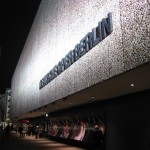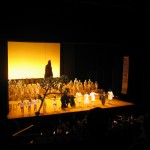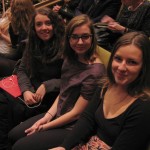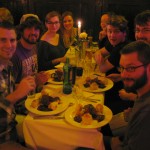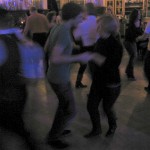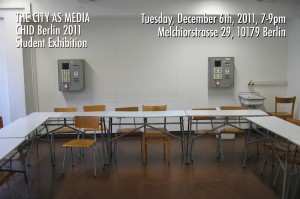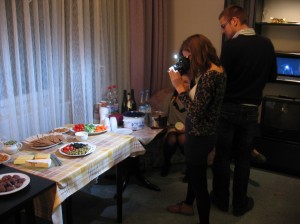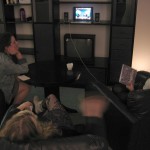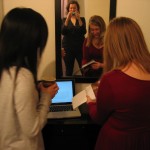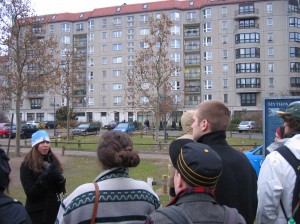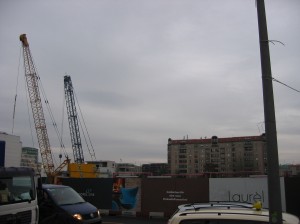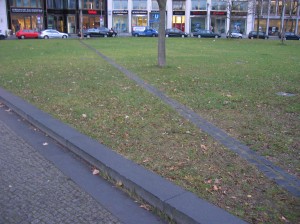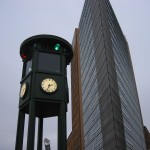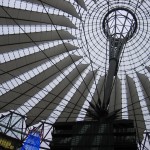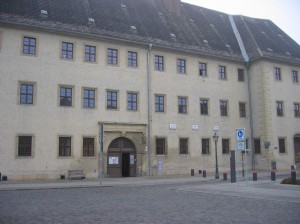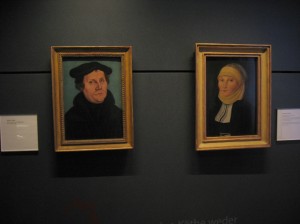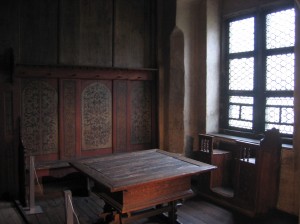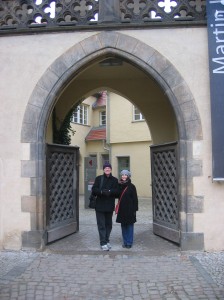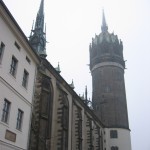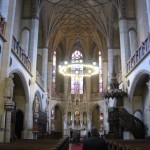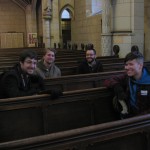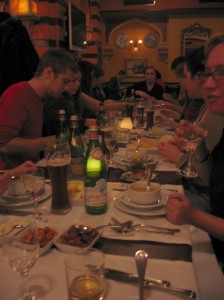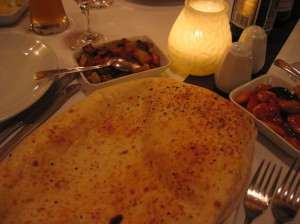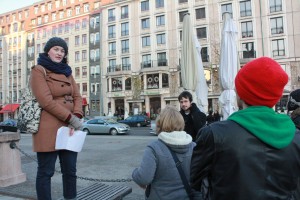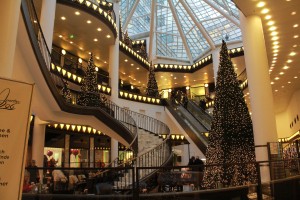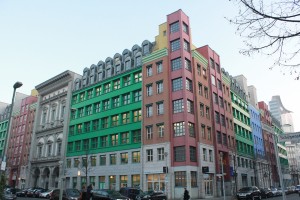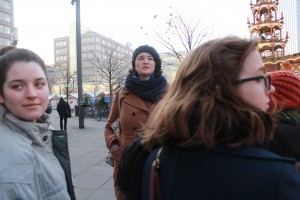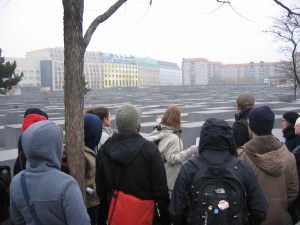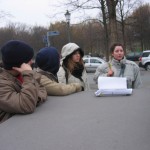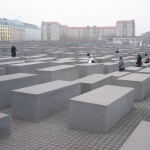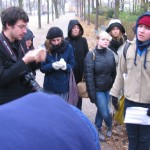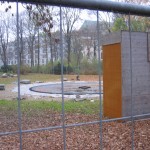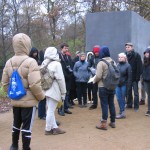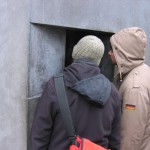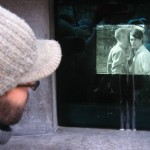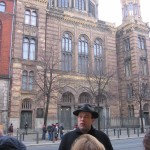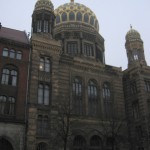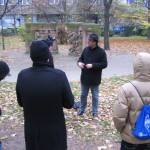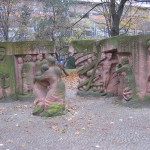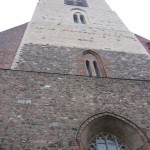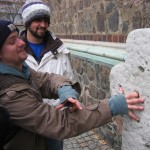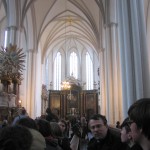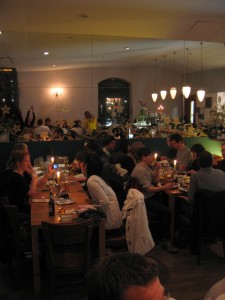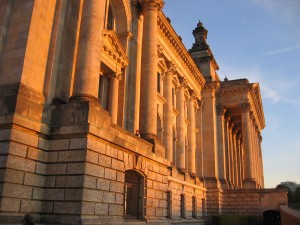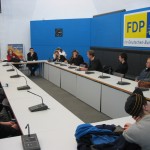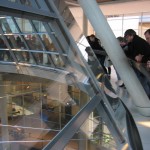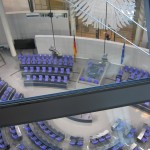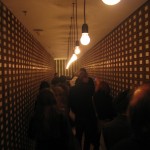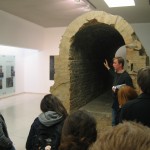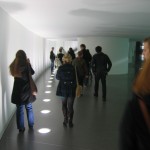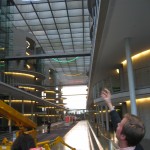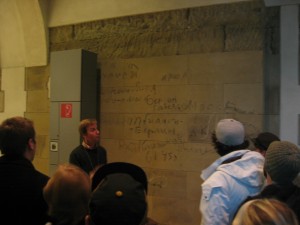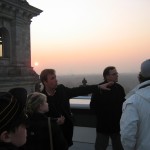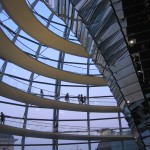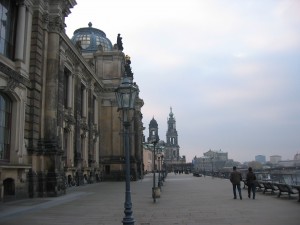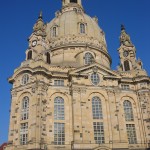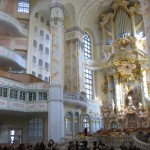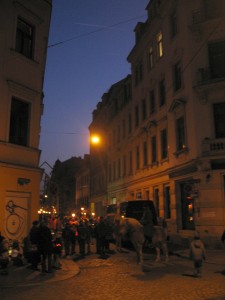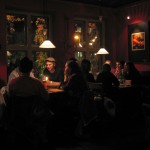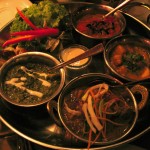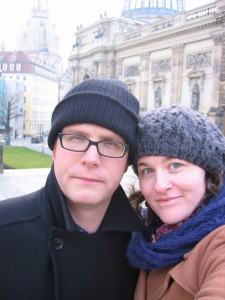Goodbyes
It’s our last week in Berlin!
We sent the students off with two fun activities: first, a trip to the opera to see Mozart’s “The Magic Flute.”
Then, we wrapped everything up with dinner and dancing at Clärchens Ballhaus, a Berlin institution that’s been around since the 1920s. Niguel and Anna tore up the dance floor with some swing moves!
It’s hard to believe that the program is already over! Ten weeks is not nearly enough time to explore a city as rich and layered as Berlin … but I think we did a pretty good job! The students will be moved out and on their way to new destinations by this weekend – some home to Seattle, and some off to explore more of the world! We hope this experience stays with them …
Student Exhibition night!
On Tuesday we held our exhibition of student work at the Adalbertsrasse apartments. Each student installed his or her work in one of the apartment spaces, along with an artist statement explaining the piece. Then we all wandered around and enjoyed their creations, just like at a real art opening.
Everyone helped out with setup, including a lovely spread …
… and the student projects were inspiring! Each one revealed a unique and interesting response to Berlin. (Shown here: Annie’s audio project and Robert’s flip book.) Several guests joined us for an evening of wandering through the building, listening to a spoken-word and music performance, and enjoying being together!
A tour of Potsdamer Platz with Natalie & Ryna
Our final student-led walk took place this week, with a tour of Potsdamer Platz and its surroundings by Natalie and Ryna.
We started out at the former site of Hitler’s bunker – now hidden under a parking lot and GDR-era apartment buildings.
Our next stop was a huge construction site on Leipziger Platz, just half a block from Postdamer Platz. This plot was once home to Wertheim’s department store, headed by the pioneering and gifted businessman Georg Wertheim. Because he was Jewish, however, he was forced to leave the country in 1937, leaving his wife Ursula in charge of the company, which eventually folded and was re-established under different ownership after the war.
Now a new shopping center is being constructed on the site. Though it’s not owned by the Wertheim family, the idea is to refer to the strong commercial history of the area.
Also on Leipziger Platz, we viewed the brick strip that marks where the Berlin Wall once ran. It’s amazing to think that this whole area was a divided, empty wasteland just twenty years ago!
Potsdamer Platz is also strongly associated with certain technological breakthroughs – it became home to one of Europe’s very first traffic lights in 1924, and it is now also a center of the film industry in Berlin. The Sony Center (right) embodies this with its hi-tech roof design.
Moving from a booming commercial center in the twenties to bombed-out no-man’s-land during the mid-twentieth century, then back to thriving retail hub today, Potsdamer Platz is emblematic of the many recent and violent transformations of Berlin. It’s a fitting end to our student tours!
A trip to Wittenberg
This Tuesday we took a day trip to the town of Wittenberg, about an hour away by train.
Wittenberg’s most famous resident was, of course, Martin Luther, who lived here in what was an Augustinian monastery and, after the Reformation, a school and his private residence.
The building is now an excellent museum on the history of the Reformation. One of its best features is the many paintings by Lucas Cranach, who was a close friend of Luther’s. Here are Cranach’s portraits of Luther and his wife Katharina, a former nun. Their marriage has become such a legend that it is reenacted every summer by the locals in Wittenberg!
A few of the rooms are wonderfully preserved, as well. Here is one of the rooms that Luther used as an everyday living space.
(John and Eleanor paused for a quick photo under the portal to Luther’s house.)
The other important site in Wittenberg is the Schlosskirche, where Luther famously nailed his 95 theses on the door in 1517. The church has burned down and been rebuilt since then, but it’s still a pretty amazing piece of history!
One thing that has really been brought home to us – especially in these last weeks, as we discuss contemporary German identity – is just how integral Christian, and in the north, especially Protestant, history is to an understanding of what many people believe it means to be German. This is where it all started, after all! And, as the history of the Reformation shows us, changing people’s assumptions can be difficult. As Germany moves into an age where multiculturalism is increasingly a feature of the social landscape, it will be interesting to see how they make sense of the shifts in religious identity, as well.
Dinner at Hasir
This Monday we had dinner at the Turkish restaurant Hasir! Turkish culture is a huge part of Berlin, and it was wonderful to enjoy some of its culinary delights … YUM!
A tour of Critical Reconstruction in Mitte with Nara
This week, I took the students on a tour focusing around the reconstruction of Mitte, the central district of Berlin. The guiding principle for this has been the concept of “Critical Reconsruction,” a set of city planning and architectural approaches that emphasize traditionalism and history.
One of the amazing things about this approach is the way that different architects have responded to the task: in Pei Cobb Freed’s Quartier 206 building, for instance, the idea of a turn-of-the-century shopping gallery has been combined with modern materials and geometries to create a rich amalgam of yesterday and today.
The same can be said for this building by Aldo Rossi. Rossi’s writing was incredibly influential on Critical Reconstruction theory, because he emphasized issues of memory – not only official, public memory, but personal and dream-like memory – in his work. As we’ve seen this quarter, Berlin is nothing if not memory-laden …
As visually appealing as much of Critical Reconstruction is, there are also problems with it. One of these is the rhetoric used by planners and architects in order to push certain projects through. Spaces such as Alexanderplatz – remodeled thoroughly in the 1960s – were dubbed “totalitarian” or “socialist,” when they actually embodied architectural types that were typical of Western architecture. This kind of language masks the real target of Critical Reconstruction: the Modernist architecture that preceded it!
As we move into an exploration of Berlin’s contemporary issues, the rifts in the various discourses about identity and space will continue to become more and more apparent.
*Special thanks to Ryna Chin for the great photos!
A tour of three Holocaust memorials with Ryder, Cassie and Michelle
Our student-led tour this week took us to the Memorial to the Murdered Jews of Europe, a large memorial in the center of Berlin. Our guides Michelle and Cassie explained the history of the site, and encouraged us to experience it for ourselves. The memorial, designed by Peter Eisenman, consists of a field of stelae meant to engender a highly personal experience for each visitor.
Our tour also included a visit to a lesser-known, though still centrally-located, memorial: the Memorial to the Roma and Sinti Murdered by the Nazis. Because of problems with the materials, it’s still unfinished. Ryder introduced us to the history of these groups, as well as some of the controversies surrounding the building of the memorial.
We also stopped to take in the memorial honoring homosexual victims of the Holocaust, and learned a little about gay history in Berlin and Germany. Together, all three of these memorials represent important gestures by the German government toward honoring the victims of the Nazis and ensuring that such a tragedy does not occur here again. We were especially lucky that our students took the time to point out the two lesser-known memorials that augment the powerful Memorial to the Murdered Jews of Europe.
A tour of Mitte with Ulf Heinsohn
This Tuesday we took a walk through cold, foggy Mitte with Ulf Heinsohn, who helped us unpack some of the layers of meaning in the architecture around us. One of our first stops was the Neue Synagoge, or New Synagogue. Built in the 1860s, the building referred to both the history of Judaism and to its connections with Berlin: the style reflects one of the high points of Jewish culture (the Moorish architecture of the medieval period in Spain, where synagogues took on a look borrowed from Islamic architecture), but it uses a local traditional material (brick).
We also stopped at the Rosenstrasse memorial, which honors the wives of Jewish forced laborers who successfully protested their husbands’ deportation. The memorial was designed by the daughter of one of these couples.
At the Marienkirche, one of the oldest churches in Berlin, we learned how the architecture reflects the changes in the church community. The windowless front of the church was built that way in order to function as a fortress in case of invasion during the late medieval period. The cross in front of the church functioned in “trials by ordeal” — if the accused could fit their fingers in all five holes, they were considered innocent!
Our walk in the cold weather definitely earned us a delicious meal. Our group enjoyed a wonderful dinner together that night at Matzbach, one of our favorite German restaurants!
A visit to the Reichstag
Our activities this week included a tour of the Reichstag (the German parliament building).
Our guide was Ulli Finkenbusch, who works for the Free Democratic Party (FDP). After an introductory discussion about some important political issues facing Germany, we took a tour of the building, beginning with the mezzanine level.
On the lower level of the main parliament building, we viewed an artwork by Christian Bolstanski (left), consisting of metal boxes with the names of all the German Parliament members since 1919. We also saw the remains of the tunnel through which the arsonist who set fire to the Reichstag in 1993 is supposed to have entered building.
We then traversed the underground walkway connecting the Reichstag with the parliament meeting rooms and offices in the Paul-Löbe-Haus.
On our way back through the Reichstag, we glimpsed graffiti left by Soviet soldiers in 1945, which has been preserved as part of the integral history of the building.
Our final stop was on the roof, where Ulli pointed out several of the city sights that are visible from there, and we enjoyed a beautiful sunset!
Dresden: Florence on the Elbe
This Friday and Saturday our class took a trip to Dresden, a beautiful baroque city on the banks of the Elbe River.
The students explored several of the historic sites in the city, including the Frauenkirche. Once a famous ruin symbolizing the firebombing of Dresden, the church has been recently reconstructed.
Since the students were all responsible for seeing the sights on their own, we don’t have images of their explorations, but you can see Annie’s, Mariah’s, Melissa’s or Robert’s blogs for their own photos.
We also learned about an interesting German holiday in Dresden: St. Martin’s Day. Families walk together around the city holding lanterns. All of the cute little kids and their homemade lanterns were quite a sight!
On Friday night, we enjoyed a delicious group dinner at a local Indian restaurant!
… and Chance and I enjoyed Dresden, too!
tags
the author
I'm a doctoral student at CUNY Graduate Center. I'm thrilled to be teaching the CHID Berlin program with Prof. John Toews! You can contact me at naraelle [at] gmail.com, or find out more about me at www.naraelle.net.
Blogroll
- Annie Holden's blog
- Cassie Hoeprich's blog
- Dominic Barrera's blog
- Janet Williams's blog
- Mariah Alderete's blog
- Melissa Au's blog
- Robert Hampton's blog
- UW Students Study Abroad Our students Natalie and Cassie are contributing to the official IPE student blog this fall!



